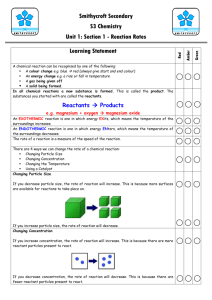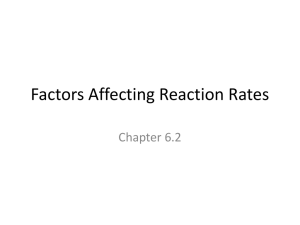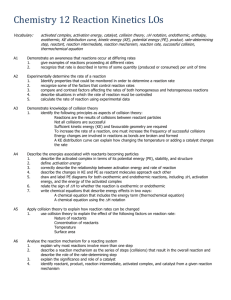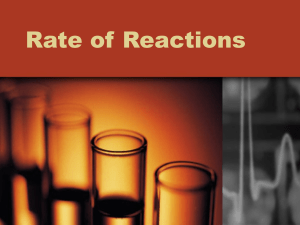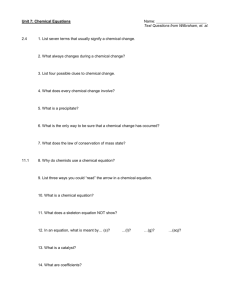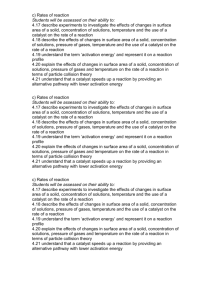Ch 16-17 Notes - Hemet High School
advertisement
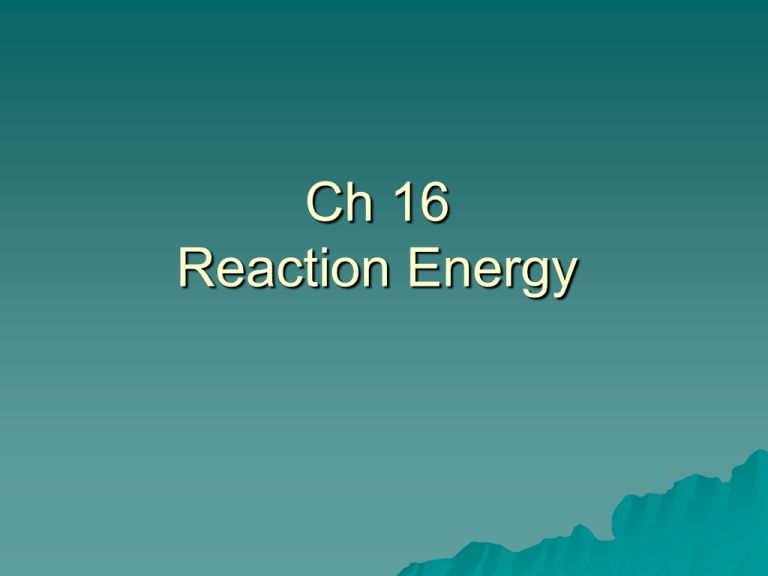
Ch 16 Reaction Energy Standard: –7.d. Students know how to solve problems involving heat flow an temperature changes, using known values of specific heat. Objective: –We will define heat, give its units, and perform specific-heat calculations. Thermochemistry Thermochemistry: the study of the transfer of energy as heat that occurs during chemical reactions and changes in state. Heat: q, is energy transferred from one object to another because of a temperature difference between them. Heat always flows from a warmer object to a cooler object and will continue to flow until they are in equilibrium. Endothermic Process: one that absorbs heat from the surroundings (+q). Exothermic Process: one that releases heat to it’s surroundings (-q). Calorimeter: the insulated device used to measure the absorption or release of heat in chemical or physical processes. Specific Heat Heat flow is measure in joules (J). One joule of heat raises the temperature of 1g of pure water 0.2390°C Specific Heat: the amount of heat needed to increase the temp of 1 g of the substance 1°C. – The specific heat is the heat capacity of an object divided by its mass in grams. Calculating Specific Heat (C) Divide the heat input, q (Joules) by the temperature change, ΔT (°C) times the mass of the substance, m (g). C= q = heat m x ΔT mass x change in temp Example The temperature of a 95.4 g piece of copper increases from 25.0°C to 48.0°C when the copper absorbs 849 J of heat. What is the specific heat, C, of copper? q = 849 J m = 95.4g ΔT = (48.0°C -25.0°C)=23.0°C C= q = 849 J m x ΔT 95.4 g x 23.0°C C = 0.387 J/(g x °C) Example 2 How much heat, q, is required to raise the temperature of 400.0 g of silver 45°C? The specific heat of silver is 0.24 J/(g x °C). ΔT = 45°C m = 400.0 g C= 0.24 J/(g x °C) q = C x m x ΔT q = 0.24 J/(g x °C) x 400.0 g x 45°C q = 4320 J Table Homework Notes 1 is on page 533. Kelvin and Celsius are interchangeable because they are on the same scale. cp is the same as C #7 solve for q #8 solve for ΔT, add that to 20°C and then convert to Kelvin. ΔT = q /(C x m) #9 solve for C #10 change mol to g and solve for C Chapter 17 Reaction Kinetics Ch 17.1 Reaction Kinetics Standard: –8.a. Students know the rate of reaction is the decrease in concentration of reactants or the increase in concentration of products with time. Objective: –We will use the collision theory to interpret chemical reactions and define activated complex. We will draw energy diagrams. Collision Theory Collision Theory: atoms, ions, and molecules can react to form products when they collide with each other, provided that the colliding particles have enough kinetic energy. Think about two balls of clay. If you throw them together gently, they won’t stick together, but if there is enough energy, they will stick together. Rate: a measure of the speed of any change that occurs within an interval of time. In chemistry, the rate of chemical change or the reaction rate is usually expressed as the amount of reactant changing per unit time. Activation Energy: the minimum energy that colliding particles must have in order to react. Activated Complex: an unstable arrangement of atoms that forms momentarily at the peak of the activation-energy barrier. This is also called the Transition Rate. Sample Problem A page 566 and Practice Problem 2 page 567 Ch 17.2 Standard: –8.b. Students know how reaction rates depend on such factors as concentration, temperature and pressure. –8.c. Students know the role a catalyst plays in increasing the reaction rate. Objective: –We will discuss the factors that influence reaction rate and define a catalyst. Factors Affecting Reaction Rates The rate of a chemical reaction depends upon temperature, concentration, particle size, and the use of a catalyst. TEMPERATURE Raising the temperature speeds up the reaction and lowering the temperature slows down the reaction. CONCENTRATION The higher the concentration, the more likely collisions will take place, which increases the reaction rate. PARTICLE SIZE The smaller the particle size, the more surface area, which increases the reaction rate. CATALYSTS Adding a catalyst will increase the rate of reaction, in some cases, better than increasing the temperature. Inhibitor: a substance that interferes with the action of a catalyst. – These will slow down or even stop a reaction Nature of Reactants The nature of the reactants involved in the chemical reaction also play a part. But just remember the first four.


